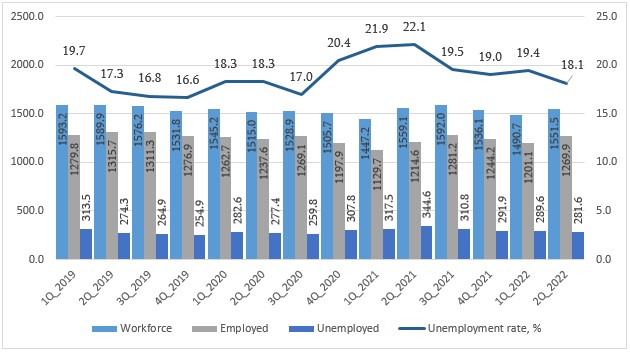Mikheil Dundua: “Nearly 70,000 more people found jobs in the second quarter as compared to the first quarter.”
Verdict: FactCheck concludes that Mikheil Dundua’s statement is MOSTLY TRUE.
Resume: The number of employed individuals in the second quarter of 2022 increased by 68,800 (5.7%) as compared to the previous quarter. Of this amount, the number of hired employees increased by 50,200 (6.1%). In the same period, the number of unemployed individuals decreased by 8,100 (2.8%).
When measuring the number of people with employment, it is more relevant to compare a given quarter to the same quarter of the previous year in order to exclude the seasonal factor. In the second quarter of 2022, the number of employed individuals increased by 55,300 as compare to the relevant period of the previous year. Of this amount, the number of hired employees increased by 36,200 (4.4%). In the same period, the number of unemployed people decreased by 63,000 (18.3%).
The employment figures in the country have indeed improved. However, Mikheil Dundua compares the number of employed people with the figure of the previous quarter. As a result, employment growth is shown higher than it actually is.
Analysis
Deputy Minister of Finance, Mikheil Dundua, stated: “In the second quarter of the year, nearly 70,000 more people found jobs as compared to the first quarter. Of this amount, over 50,000 people started employment with labour remuneration at their job… This indicates that economic growth is reflected on the employment rate and on prosperity levels. According to yearly calculations, the number of unemployed people decreased by 18% which is 60,000 people.”
Job losses owing to the stringent long-term economic restrictions amid the pandemic (2020-2021) created a particularly acute problem. Lifting the regulations logically enabled a recovery in different economic parameters, including employment figures. In the first and second quarters of 2022, workforce indicators increased sharply although pre-pandemic figures are yet to be recovered.
According to the National Statistics Office of Georgia, the number of employed individuals increased by 68,800 (5.7%) in the second quarter of 2022 as compared to the previous quarter. Of this amount, the number of hired employees increased by 50,200 (6.1%). In the same period, the number of unemployed individuals decreased by 8,100 (2.8%).
An incorrect understanding of employment statistics can occur if the seasonal factor is not considered whilst measuring the number of employed people or when comparing particular quarters. [1] Therefore, it is more relevant to compare the figures of the current quarter to the same quarters of the previous year(s) in order to analyse trends identified in the previous periods.
In the second quarter of this year, the number of employed people increased by 55,300 (4.5%) as compared to the same quarter of the previous year and reached 1,269,900. Of this amount, the number of hired employees increased by 36,200 (4.4%) and reached 867,900 whilst the number of self-employed individuals increased by 19,400 (5.1%) and reached 401,200. In the same period, the number of unemployed people decreased by 63,000 (18,3%) and dropped to 281,600.
In the second quarter of 2022, the unemployment rate shrank by 4.0 percentage points as compared to the same period of the previous year and now amounts to 18.1%. In the same period, the employment rate increased by 2.1 percentage points and reached 42.2%.
Graph 1: Workforce Figures (Quarterly Data) in 2019-2022

Source: National Statistics Office of Georgia
It is a fact that there is a trend of improvement vis-à-vis employment figures and the drop in the unemployment rate in the first and second quarters of 2022 may be considered as a recovery of jobs that were lost amid the pandemic. The context of the statement of the Deputy Minister of Finance that employment figures in the country improved is true. However, Mikheil Dundua compares the number of employed people to the indicator of the previous quarter and disregards the seasonal factor which thereby exaggerates the figures and shows the existing indicators to be higher than they actually are.
[1] This depends on data interpretation; particularly, the content of a statistical figure.








